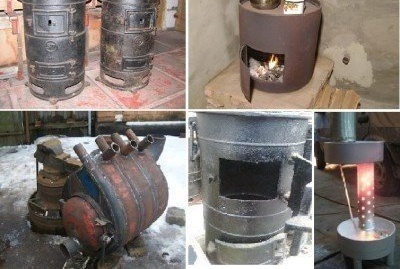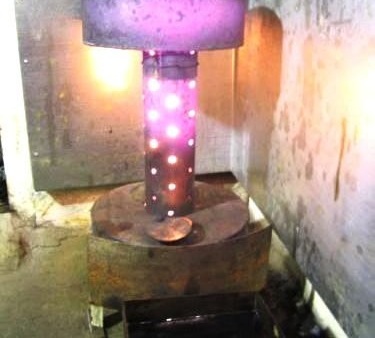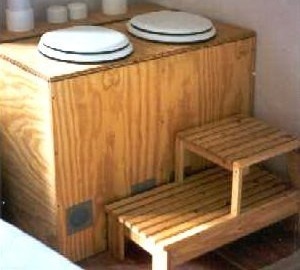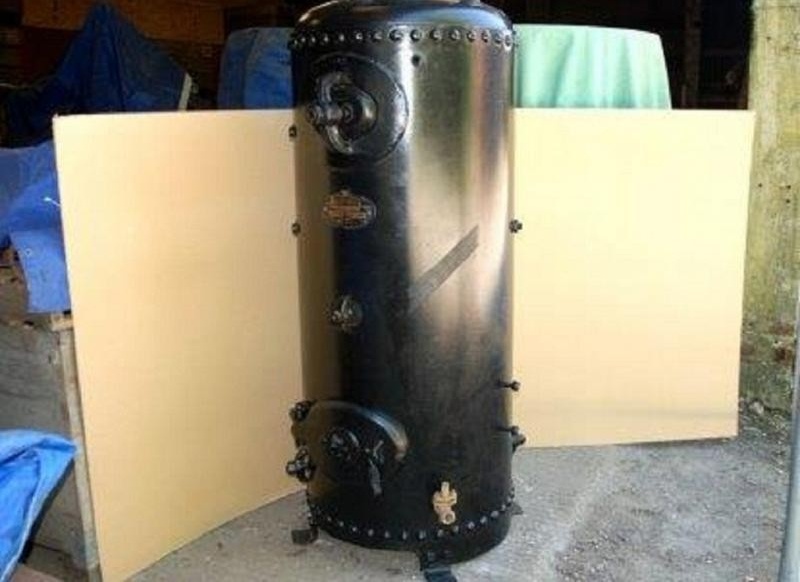Do-it-yourself stove stove for a summer house and a garage: instructions for self-manufacturing
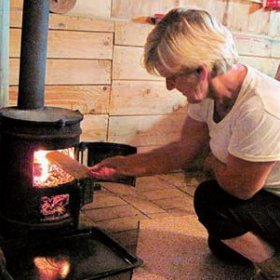
Everyone knows the cheapest and easiest option for heating a summer house or garage - this is a stove-potbelly stove. The modern design allows it not only to work with great efficiency, but also to use almost everything as fuel: firewood, coal, peat, used industrial oils, paint and varnish waste and diesel fuel. The market today offers such models that are a true masterpiece of design thought. This is no longer a rusty pipe, which can only be put in the garage, but an object around which the interior of the room and the house is built.
Design features and specifications
A “potbelly stove” appeared at the beginning of the nineteenth century. It was an expensive thing, it required a lot of firewood, and accordingly, only wealthy people could afford it. In Europe, it was called the “metal furnace”, and after the February Revolution in the vastness of our homeland it was called the “potbelly stove”. Since then, it has been strongly associated with poverty, domestic inconvenience and devastation.
The original design was a metal cylinder or box, standing on iron legs. The stove had a door and a pipe for the chimney. Just to impossibility, and therefore ineffective. If the fire died out, the walls of the furnace instantly cooled. To maintain an acceptable temperature, it was necessary to constantly throw firewood.
But time passed, the design was improved and altered for various types of fuel, and the furnace itself was given a noble appearance. So the "potbelly stove" began its victorious procession and appeared in every second garage and in every third cottage. She not only heated, but also cooked: you can boil the kettle on the surface and fry the omelette. Now this is no longer an ordinary pipe with a furnace, but a reliable heating device, which is also an interesting interior item.

The stove-potbelly stove can become that subject around which the interior of the whole dacha will be built
A modern stove-stove for a summer residence and a garage copes with heating a room, the area of which is fifty to sixty square meters. The design itself has undergone significant changes. It appeared:
- Slow burning mode. A special lock tightly closes the door and avoids smoke. Valves installed on the air intakes of the ash pan and the door, you can adjust the air flow and the intensity of combustion;
- Flue gas afterburning system, which is installed at the top of the firebox. It increases the efficiency and reduces the temperature of the smoke that enters the pipe;
- Heat resisting facing of internal walls. To do this, use fireclay or other refractory materials. They retain heat longer and protect the metal from overheating, thereby extending the life of the furnace;
- Heat resistant glass insert. It is placed on the firebox door. In the evenings you can enjoy the fire.
The model of the model is different, but as a class of heating equipment, stoves for the summer cottage and garage have several advantages:
- Fast kindling. To start warming up the room, ten minutes is enough for her, while an ordinary masonry stove will take several hours;
- High efficiency (up to 80%). The introduction of convection, heat-resistant lining and afterburning allowed stoves to compete with other heating systems in their heating characteristics;
- Uniform heat distribution. No matter where the stove stands, it will equally heat the entire space around it, unlike fireplaces;
- Variety of fuel. Depending on the model and the room in which it is installed, firewood, peat, sawdust, used oils and paint and varnish waste can be used for heating;
- Low cost of the furnace itself. A potbelly stove costs significantly less than a fireplace or a masonry stove;
- Profitability. Many maintenance models are cheaper than the same electrotenes of similar power. For example, a waste oil stove saves about 60% of the cost of heating a garage, compared to electric heaters;
- Possibility of use as a plate, hot water boiler and interior design object.
The disadvantages of all models are:
- Inability to accumulate heat. Cast-iron stove stoves for giving heat the room as long as fire burns in them. Once he goes out, and the temperature begins to drop;
- The need for continuous fuel supply. The maximum time between bookmarks of firewood is three to four hours, and this is in the most modern models;
- High chimney. To obtain traction, you need a pipe with a height of at least four meters;
- The need for continuous cleaning of the chimney. You need to clean it once a week, if the diameter of the pipe is small, if large can be done once every six to eight weeks.
But, as a rule, the low cost of manufacture covers all the disadvantages.
How to make a potbelly stove on waste oil?
If you don’t want to put a homemade stove in the cottage because of its not aesthetic appearance, then in the garage it does not matter. Motorists are well aware that a potbelly stove for a garage can be welded with their own hands in a few hours.
You can make the usual round, you can wireframe or even buleryan. But the most popular scheme for car enthusiasts is the used oil potbelly stove.

The working potbelly stove is the most popular and economical model for a garage. You can heat it with waste technical oils or paint and varnish waste
For its manufacture you will need:
- grinder (circle diameter 125 mm) with cutting and cleaning circles;
- perforator (drill diameter 13 mm);
- carrying;
- sledgehammer;
- welding machine (not less than 200 amperes);
- hammer slag separator;
- rivets;
- corner for legs;
- chisel;
- pliers;
- a hammer;
- protective glasses;
- roulette;
- a piece of chalk.
All welding work must be performed in a special protective mask and in overalls.
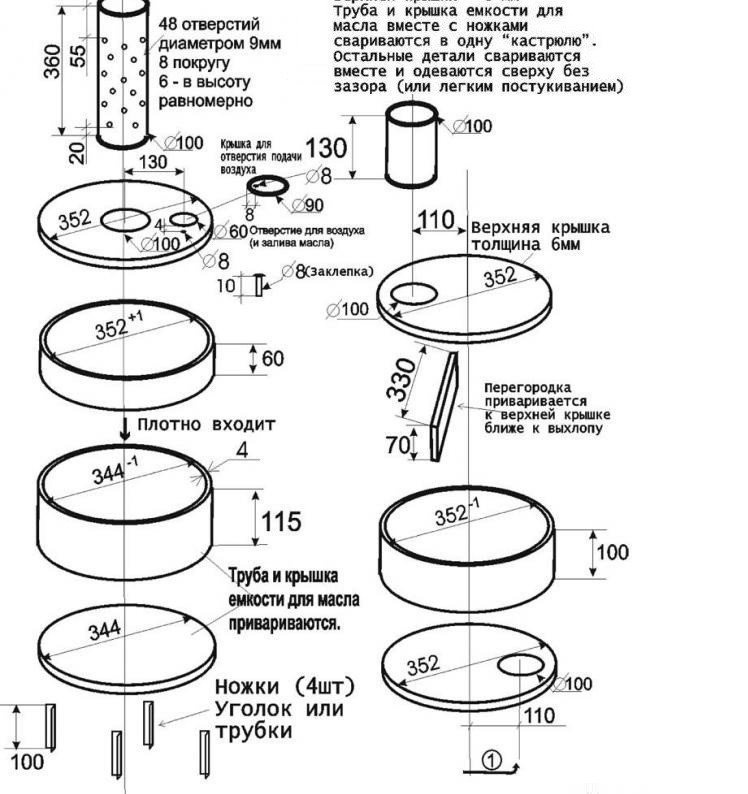
The scheme of the device of such a stove (click on the picture to enlarge it). Some advise increasing the diameter of the holes from 9 to 11 millimeters
The working furnace has an oil consumption of 0.5 to 1.5 liters per hour, weight - 27 kilograms and overall dimensions - 70 * 50 * 35 centimeters without a chimney.
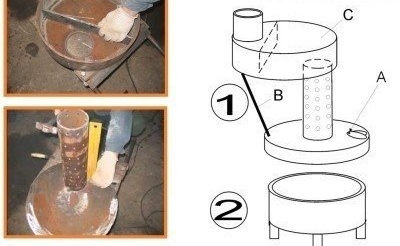
To give stability to the structure, a corner (B) is welded, the cover (A) can be screwed on or riveted, it should move freely
The upper part (1) is put on the lower (2) without a gap, after which a chimney is installed. It is stretched at an angle of four meters and more vertically. When welding the bottom "pan", be sure to check the tightness of the seams to prevent smudges of oil.
The cover (A) is riveted to the body. It should rotate freely, thereby regulating the volume of incoming air and oil.To give greater stability to the structure, a corner (B) is welded. The upper platform (C) is the hottest spot on the stove. On it you can cook, heat water. If you put airflow (fan) at a safe distance, then the efficiency of the furnace will increase.
Since the upper platform (C) is red-hot during operation, it usually burns out during a year of continuous operation. You can take 3 mm steel so that the potbelly stove lasts longer. With your own hands you can make paint by mixing 200 milliliters of liquid glass, 80 grams of aluminum powder and 8 grams of chalk. This amount is enough to color one stove.
Such designs look as follows:
For ignition, several liters of oil are poured into the furnace, about a hundred grams of heating oil is placed on top of it, a rag or paper is placed, which is set on fire. Refining is added in small batches as necessary. And to increase the efficiency of the stove, you can weld several pieces of a metal corner to the side walls of the body.
Classic massive brick stoves take up too much space. Much more practical, compact and economical potbelly stove for giving. With your own hands it can be made of steel or cast iron, a water tank can be welded or heating pipes can be connected. You can even cook on it. And if you purchase a potbelly stove with a glass insert on the firebox door, then in the evenings you can sit and enjoy the fire.
